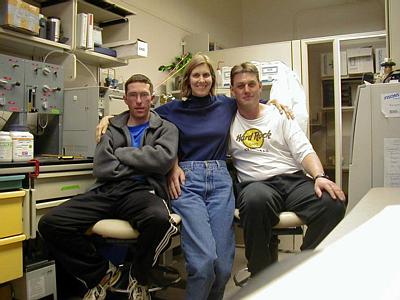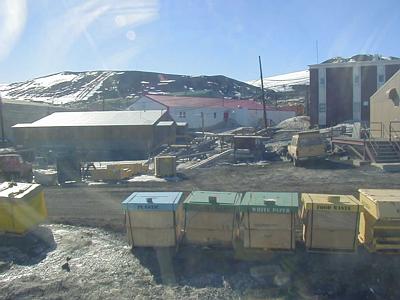9 December, 1999
McMurdo Station, Ross Island, Antarctica
Thursday
I had visitors in the lab today! Rob, who has stopped by on several
occasions, came by for a few minutes to help me with a computer question.
Nigel and Tony of the Kiwi Cargo crew, came by to see what I do all day! It
was nice to have visitors to break up the monotonous cycle of inject, watch,
wait, record, inject, watch, etc.
Bess, Mark, and Maite went to West Lake Bonney for our last sampling day.
Julie and I puttered around the lab and worked on the gas samples. I spent
some time organizing my rock samples. I have a permit for 10 pounds of
rocks. My rocks weighed in at a whopping 29 pounds! I think I'll have to
amend my permit!
It was a fine, quiet day here. I sat at the gas chromatograph looking
through the window at the sun shining brilliantly over McMurdo. My view
isn't spectacular, but it's a view nonetheless! When the weather is warm
and not windy, it's difficult to be indoors! Today was one of those days!
Julie and I finished our work a little after 10 p.m. (I had started the day
at 6:30 a.m.). We took the now familiar path to Gallagher's where we played
a game of pool by ourselves and then another with a Kiwi C-130 flight crew.
I was actually on the winning side of things even though I didn't sink a
single ball!
Julie and I spent time talking about how this trip to Antarctica has changed
our lives. We recognized that one cannot experience what we have
experienced and come away unmoved. We wondered what other adventures the
world holds for us!
ANSWER TO YESTERDAY'S QUESTION: The first part of the question was a trick!
There are no fish in Lake Bonney! The largest organism is a nematode that
is microscopic! If you fished in the ocean around Antarctica, you would
find many varieties of fish. There are over 270 species of fish in the
Southern Ocean. Some of these fish are able to tolerate sub-zero water
because they contain an anti-freeze in their blood. Several of the
scientists here are studying these fish and how this anti-freeze works to
keep the fish from freezing. I've included a photo of the Antarctic Cod.
TODAY'S QUESTION: What kinds of penguins are in Antarctica? Do you find
penguins anywhere else in the world?
Sharon
JUST FOR KIDS!!!!!
Bess, Mark, and Maite were at Lake Bonney all day today. Julie and I worked
in the lab. We sat at the gas chromatograph. We organized our rock
samples. I am allowed to bring back 10 pounds of rocks. I have 29 pounds!
How many pounds over my limit am I? What do you think that I should do?
ANSWER TO YESTERDAY'S QUESTION: The first part of the question was a trick!
There are no fish in Lake Bonney! The largest organism is a nematode that
is microscopic! If you fished in the ocean around Antarctica, you would
find many varieties of fish. There are over 270 kinds of fish in the
Southern Ocean. Some of these fish are able to live in water that can
freeze because they contain an anti-freeze in their blood. Several of the
scientists here are studying these fish and how this anti-freeze works to
keep the fish from freezing. I've included a photo of the Antarctic Cod.
TODAY'S QUESTION: What kinds of penguins are in Antarctica? Do you find
penguins anywhere else in the world?
Sharon

Kiwi Cargo-ologists Nigel and Tony visit me in the Analytical Lab. This is where I work on the gas chromatograph.

An Antarctic Cod in a holding tank in Crary Lab. These fish are about 6 feet in length!

More Antarctic Cod...

The view from the gas chromatograph!
Contact the TEA in the field at
.
If you cannot connect through your browser, copy the
TEA's e-mail address in the "To:" line of
your favorite e-mail package.
|
